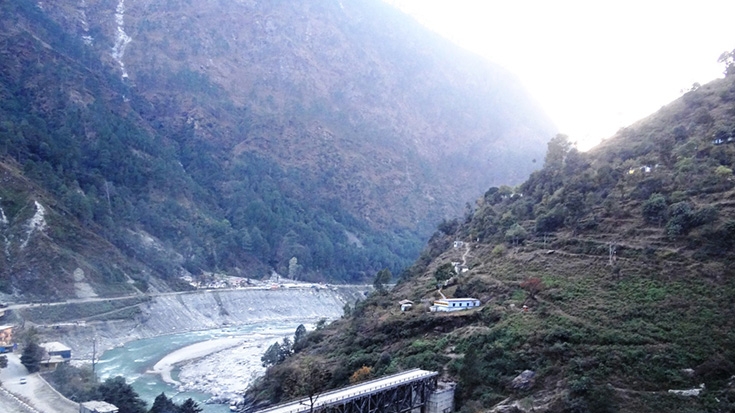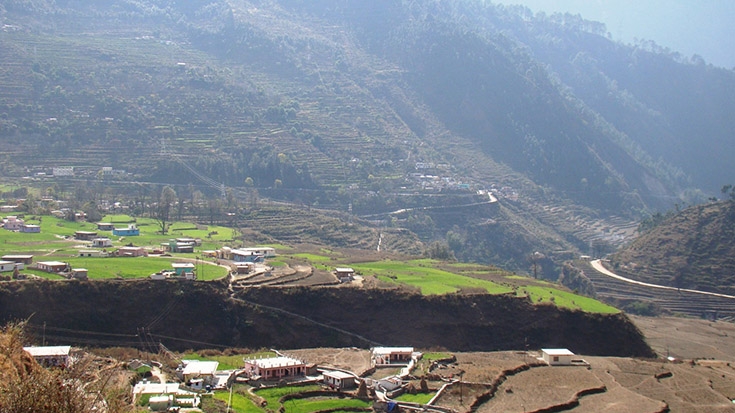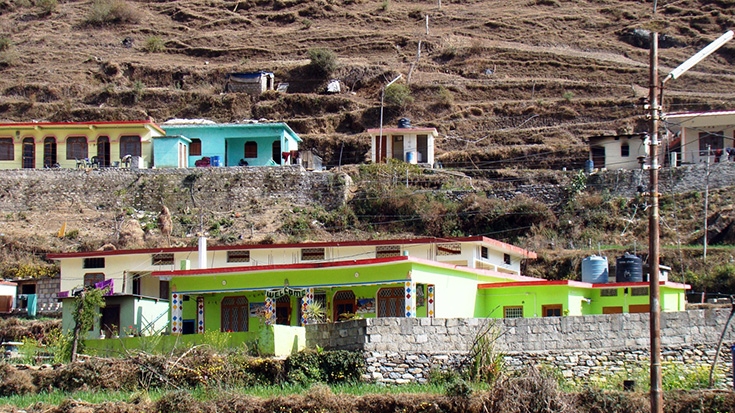Relocation Progress:
The villagers of Haat have begun building their new houses across the river, with facilitation from THDC. As of December 2013, 57 households from Haat had received the first installment of the special grant of Rs 1 million and, 53 have received the second installment, while 7 households have received the third and final instalment as well. A committee headed by the district Chief Development Officer has identified another 10 households as being eligible for the special grant. As these households had alternate houses in Mayapur, it was agreed that the grant would not be linked to construction in their case but would be paid in a single instalment. Four households have already received this one-time payment. So far, a total sum of Rs. 41.2 million has been disbursed against this Special Package.
Some 54 families have completed the construction of their new houses on the left bank of the river at sites in Daswana, Eldana, Mayapur and Agthala villages, in keeping with the agreed relocation plan for Haat. Forty five families have already moved into their new homes. Apart from these families from Haat, three households which were not residents of Haat, have also constructed their houses in Eldana.
THDC is in the process of setting up the community infrastructure for these new settlements. Eldana is already connected to the highway and THDCIL plans to link Daswana village to the national highway by a road via Garhi village; the tenders for this are currently being processed. Both the relocation sites of Daswana and Eldana have been linked to water supply sources and water tanks also installed to augment water availability for the families living there. Electricity supply to houses has been connected and THDCIL has provided street-lights for the new settlements.
THDC will not only help relocate the government-run primary school of Haat to the new site (the money for constructing the new building has already been deposited with the state government in the form of compensation) but is also planning to build a new secondary school in the area in response to a demand voiced by the community. Other facilities that will also be provided include panchayat ghars at Daswana and El Dana, a baraat ghar and an anganwaadi. These will all be constructed by the state government with financial support from THDC. The gram panchayats will identify the appropriate land. The primary school and the anganwaadi are already functioning in accommodation rented by THDCIL for the purpose.
The Hamlet of Hatsari: When the village of Haat chose to relocate, eight families in the hamlet of Hatsari within Haat opted not to relocate. In order to limit the land acquisition impacts on Hatsari, THDCIL altered the project design and shifted the location of the switchyard from Hatsari to already acquired government forest land, and also realigned an access road. In its present design, the project requires no land from Hatsari. However, in the interest of minimizing the disturbance to these families of Hatsari during the construction period, THDCIL would prefer to facilitate their relocation, if only on a temporary basis, on terms equal to those to which the majority of the residents of Haat agreed. Negotiations with these families at Hatsari are ongoing.
Fuel & Fodder Allowance: THDCIL will compensate villagers for loss of access to community forestlands that it will be acquiring for the Project. The District Magistrate of Chamoli has finalized a list of 594 households from eight villages, namely Math Jadetha, Guniyala, Naurakh, Gulabkoti, Jaisal, Haat, Tenduli Chak and Batula, for the annual compensation for loss of fuel and fodder. THDC has so far disbursed Rs 9.2 million. Out of 594 households, 533 have received the first year’s compensation and 391 households have received the compensation for the second year also.
Livelihood Restoration: In order to ensure that the livelihoods of local people are not adversely affected by the project, THDCIL has drawn up an Income Restoration Plan. Under this, the Company has assisted the affected villages to form 21 co-operative societies which undertake small community infrastructure works like road repairs, building bunds and gabion walls etc. of value up to Rs 200,000.
THDCIL has also, to date, provided direct or indirect employment to 70 project affected persons either in the Company or through contractors and as sub-contractors. These opportunities for employment will increase when the major construction works start.
THDCIL is constructing a small shopping centre in Jaisal near its staff colony. Nine of the total 14 shops will be allocated to project affected families from Jaisal village.
THDCIL is also helping project affected persons get vocational training in various trades such as motor mechanics, marketing, hospitality, including a one-year diploma in hotel management from Dehradun. The company is also collaborating with the Industrial Training Institute (ITI) at nearby Gopeshwar to ensure that 20 percent of seats in this institution are guaranteed for youths from families affected by VPHEP. The ITIs at Rudraprayag and Srinagar have also been requested to provide short term courses in areas of use to the hydropower industry so that trainees can be absorbed in various hydro projects upon completion of their training.
Other income restoration schemes include distribution of high-yield seeds and fruit saplings and activities such as dairy development (in Guniyala village), vermicomposting, and napier grass cultivation. Self-help groups of women from Haat village are being assisted to start small knitting units. A more detailed Training Needs Assessment for individual project affected persons will soon be conducted to better design individual livelihood restoration plans.
Corporate Social Responsibility: CSR activities have been well planned with the involvement of community and are being regularly implemented. So far, community works worth Rs 4 million have been implemented in various project-affected villages and more worth around Rs 5 million are under implementation. These include works like building pathways, ropeways and drinking water schemes for these remote mountain villages. THDCIL has already spent more than Rs 21 million on these activities. The Company is also financing scholarships for meritorious students from project-affected villages to help them build better futures for themselves. So far, 367 students (of which 201 are girls ) have received these scholarships. THDC is now planning to also introduce a pension scheme for widows.
Grievance Redress Committee (GRC): The GRC established under the project is working well to address issues referred to it by project-affected people (PAPs). So far, 16 formal and 40 informal meetings of the GRC have taken place. Only one case has been referred to the Commissioner for Land Acquisition and Resettlement and Rehabilitation. In response to a suggestion from project-affected people the GRC will occasionally hold its meetings in project-affected villages rather than always in THDCIL’s project office.
Monitoring and evaluation (M&E): THDCIL has engaged an M&E consultant team whose quarterly reports will be available in the VPHEP Project Information Centre and on the THDC website.
MANAGEMENT OF ENVIRONMENT IMPACTS
As project activities pick up pace, THDCIL is gearing up to ensure that the local environment is not unduly impacted. The Environment Cell at site has been staffed with environment and safety assurance officers and the Company is in the process of retaining a panel of national and international-level experts to help guide them in the management of these impacts as per the Project Environment Management Plan (EMP). Another level of monitoring for the EMP will be provided by a third-party agency whose selection process is almost complete. The contractor for the civil works will support THDCIL in the implementation of the EMP; the contract document has strict environment-related obligations laid out in it.
Muck Disposal: THDCIL has made arrangements for the effective disposal of the debris that will be generated by the excavation works. It has identified four sites and, after approval from the Uttarakhand Pollution Control Board, designated them as the areas where the muck will be delivered. The contract document for the civil works mandates the contractor to dump the debris in only these areas and to build strong retaining walls to ensure that no muck falls into the river.
Catchment Area Treatment Plan: The Company has budgeted Rs 4.7 million for improving and restoring the river’s catchment area; this important activity will be implemented by the State Forest Department on the basis of funds provided by THDCIL. The Company will liaise closely with the Department on a detailed plan for implementation and monitoring of the CAT Plan.
ISO Certification: THDCIL has worked to improve its systems and acquire the ISO 9001:2008 certification on Quality Management Systems and also the ISO: 14001:2004 certification on Environmental Management Systems. These certifications are valid until March 2015.
Archeological Management: The Company THDCIL has engaged the Archaeological Survey of India (ASI), Dehradun, to help lead the archeological preservation and restoration management of the Laxmi Narayan temple at Haat. The team from ASI will visit the site shortly to begin the conservation works.
Monitoring: THDCIL proposes to introduce third-party monitoring of the environmental management of the Project. The Indian Council for Forestry Research and Education (ICFRE), Dehradun, has been identified for monitoring the CAT Plan works and another agency is being identified to monitor the other elements of the EMP. THDCIL has prepared a consolidated environmental monitoring format based on the EMP and on activities mandated by (a) the environment and forest clearances, (b) the conditions of the Pollution Control Board’s NOC to the project, (c) actions agreed with community during public hearings of the project, (d) ISO 14001 requirements; and (e) any other requirements identified in the bid documents.



